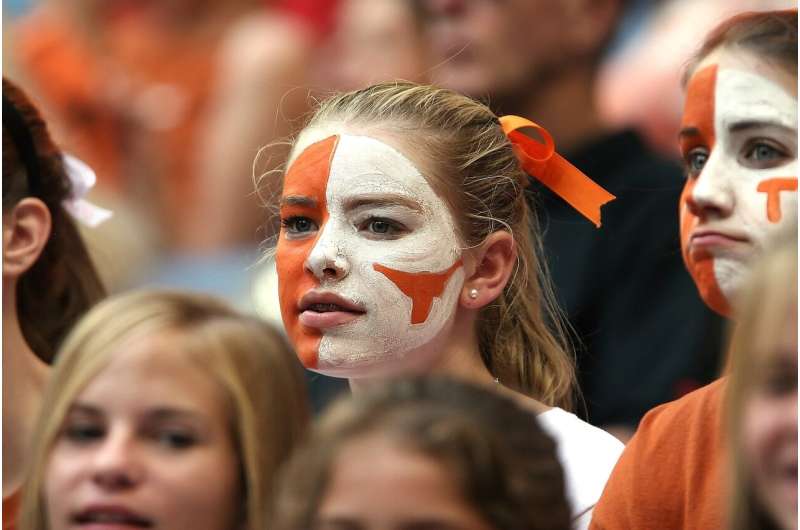This article has been reviewed according to Science X's editorial process and policies. Editors have highlighted the following attributes while ensuring the content's credibility:
fact-checked
trusted source
proofread
Women's and girls' sports: More popular than you may think

The number of Americans who watch or follow girls' and women's sports goes well beyond those who view TV coverage of women's athletic events, a new study suggests.
In fact, just over half of American adults spent some time watching or following female sports in the past year, the results showed.
According to the researchers, U.S. adults spend about one hour a week consuming female sports content, which may seem higher than expected. Still, it is only a small fraction of Americans' overall sports consumption.
The study was unique in that it took a broad look at how Americans consume female sports and incorporated all types of involvement, said Chris Knoester, co-author of the study and professor of sociology at Ohio State University.
That could include those who watched girls participate in high school athletics, read about female athletes in sports publications, and watch professionals live or on TV.
"It's not just people who are passionate and invested who consume girls' and women's sports," Knoester said.
"Sometimes it's parents watching their daughters play soccer, or sports fans who are flipping through channels looking for something to watch, or a person who reads about female sports stars."
The study, which was published recently in the Journal of Emerging Sports Studies, was led by Rachel Allison, associate professor of sociology at Mississippi State University.
Allison noted that there have been intriguing signs that interest in women's sports has been growing, such as the National Women's Soccer League setting a new attendance record of more than 1 million fans this past season and a record-breaking 55,000 people attending a women's college basketball exhibition game.
"But there's surprisingly little research on consumers of women's sports—this is one of the first studies to examine how common it is for American adults to watch or follow women's and girls' sports," she said.
Survey data came from the National Sports and Society Survey (NSASS), sponsored by Ohio State's Sports and Society Initiative.
The survey was completed by 3,993 adults who volunteered to participate through the American Population Panel, run by Ohio State's Center for Human Resource Research. Participants, who came from all 50 states, answered the survey online between the fall of 2018 and spring of 2019.
Because NSASS participants are disproportionately female, white, and Midwestern, the researchers weighted the survey results to reflect the U.S. population more accurately.
Results showed that 55% of respondents said they spent at least some time over the previous year watching or following female sports. The survey did not define what it means to "watch or follow" sports, so responses are based on participants' perceptions of those terms.
However, 60% of respondents reported watching or following female sports none or almost none of the time.
The researchers estimated the number of hours participants spent watching or following girls' or women's sports over the past year by taking the total hours of watching/following sports and multiplying that by the approximate proportion of time they reported watching or following female sports.
The result: Researchers estimated survey participants watched or followed female sports for about an hour a week.
"It was relatively moderate levels of consumption of female sports," Allison said.
The study also dug into who was most likely to take in women's sports. Lesbians were a key audience for women's sports, results showed, and were among those most likely to be avid consumers.
"But we did find some evidence that men disproportionately consume more total hours of female sports than women do, which is really striking," Knoester said.
The reason appears to be that men tend to follow and watch much more sports in total than women do, so they come into contact with more female sports.
People's family background also played a key role. As might be expected, people whose families were deeply embedded in sports in general had more interest in following or watching female athletes. Having more girls and women family members encouraged more exposure to and appreciation of female sports.
"In particular, having mothers who were highly athletic or who were involved as a sports fan seems to elevate people's consumption of women's sports, even later in adulthood," Allison said.
The study also examined how beliefs about women and men in society and sports were related to women's sports consumption.
Not surprisingly, those who thought that women were inferior to men in sports were less likely to watch or follow them.
But, curiously, those who didn't believe women and men were equals—for example, those who said husbands should make all important decisions in a family—were also more likely than others to be women's sports consumers. The same was true for those higher in homophobia.
The researchers believe that may be because sports, in general, tend to attract men who have less egalitarian and more homophobic views.
Overall, the researchers say the findings show that there is already moderate interest in women's and girls' sports and that it is growing and has the potential to grow even larger.
"Even though women's sports receive less than 5% of all sports media coverage, according to some estimates, our results suggest that the interest may be larger than assumed," Knoester said.
Allison added that knowing the audience is critical.
"What we are learning about who watches and follows female sports is critical to successful marketing efforts and audience building," she said. "It can help women's sports achieve a higher level of commercial success."
More information: Who Watches and Follows Girls' and Women's Sport? A Gendered Life Course Analysis of U.S. Adults' Consumption,Journal of Emerging Sports Studies (2023). journals.library.brocku.ca/ind … ticle/view/4552/3292
Provided by The Ohio State University



















